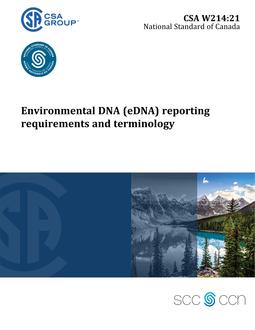Preface
This is the first edition of CSA W214, Environmental DNA (eDNA) reporting requirements and terminology. Users of this Standard are reminded that additional eDNA study design, methodology, and reporting requirements may be specified by federal, provincial/territorial, municipal, or other authorities, or by a project owner, depending on the larger study objectives. This Standard should not be considered as a replacement for the requirements contained in any a) applicable federal, territorial, or provincial statute; b) regulation, licence, or permit issued pursuant to an applicable statute; or c) contract that an owner has with a contractor. CSA Group acknowledges that the development of this Standard was made possible, in part, by the financial support of the Standards Council of Canada (SCC). This Standard has been developed in compliance with Standards Council of Canada requirements for National Standards of Canada. It has been published as a National Standard of Canada by CSA Group.
Scope
1.1 General This Standard applies to the reporting of information regarding the conducting of eDNA biological surveys or assessments. This Standard provides a) definitions for terms that are routinely used in the description of eDNA studies; and b) minimum reporting requirements for eDNA studies in a quality assurance/quality control context, including the following: i) survey project goals and objectives; ii) survey design; iii) metadata collection; iv) different types of substrate collected from the environment; v) sample collection, labelling, handling, and preservation; vi) extraction of nucleic acids (i.e., DNA, RNA); vii) various analytical methods (qPCR, metabarcoding, metagenomics, metatranscriptomics, etc.); viii) overall survey analysis and interpretation; and ix) assessing the possibility or probability of Type 1 (false positive) and Type 2 (false negative) errors.
1.2 Users This Standard is intended for use by the following: a) proponents of resource development projects whose businesses can have either direct or indirect influences on natural systems, particularly aquatic systems, and whose development projects depend on social and regulatory acceptance of transparent science-based studies of natural ecosystems in the interest of accurately understanding and describing project-related effects; b) industrial proponents who conduct activities with potential ecological impacts; c) regulatory agencies including, but not limited to, federal, Indigenous, provincial, and municipal resource managers; d) contract administrators who oversee projects that utilize any aspect of eDNA methodology; e) non-government stakeholders, including environmental non-government organizations, that review or audit eDNA projects for compliance with reasonable expectations for due diligence. This may include consideration in a legal setting, under court review, to ensure professional diligence during execution and reporting of projects that utilize any of the genetic approaches described in this Standard; f) professional biologists and qualified environmental professionals who might audit a project to ensure competency and completeness; g) academic researchers and educators, for the purposes of improving and advancing the collective field of genetics research; and h) others with a vested interest in eDNA studies, including aspects of project design, execution, and results interpretation.
1.3 Application The requirements provided in this Standard apply to practitioners engaged in the delivery of eDNA studies and reporting of their results. Project results could influence decisions on the conservation and management of natural resources. Application of the Standards outlined herein will enable effective evaluation of eDNA methods during project implementation and enhance confidence in decision-making based on the project results.
1.4 Intended use This Standard applies to the minimum reporting requirements for the planning, execution, analysis, interpretation, and reporting of eDNA projects. This Standard can be used in conjunction with other Standards, e.g., ISO/IEC 17025, to enable laboratories to demonstrate that they operate competently and generate valid results to further promote confidence in eDNA surveys. This Standard does not prescribe nor endorse any particular eDNA approach or methodology. This Standard is not intended to constrain future developments in eDNA approaches, methodologies, or applications. Many elements of this Standard are relevant to multiple steps in the eDNA workflow. To reduce repetition, the requirements have been strategically placed within the document. Users should read this Standard in its entirety. Where quantitative measurements are required, users should report these measurements using relevant standard measures and units.
1.5 Terminology In this Standard, “shall” is used to express a requirement, i.e., a provision that the user is obliged to satisfy in order to comply with the Standard; “should” is used to express a recommendation or that which is advised but not required; and “may” is used to express an option or that which is permissible within the limits of the Standard. Notes accompanying clauses do not include requirements or alternative requirements; the purpose of a note accompanying a clause is to separate from the text explanatory or informative material. Notes to tables and figures are considered part of the table or figure and may be written as requirements.
Product Details
- Published:
- 11/03/2021
- ISBN(s):
- 9781488337949
- Number of Pages:
- 31
- File Size:
- 1 file , 1.5 MB
- Product Code(s):
- 2429451, 2429451
